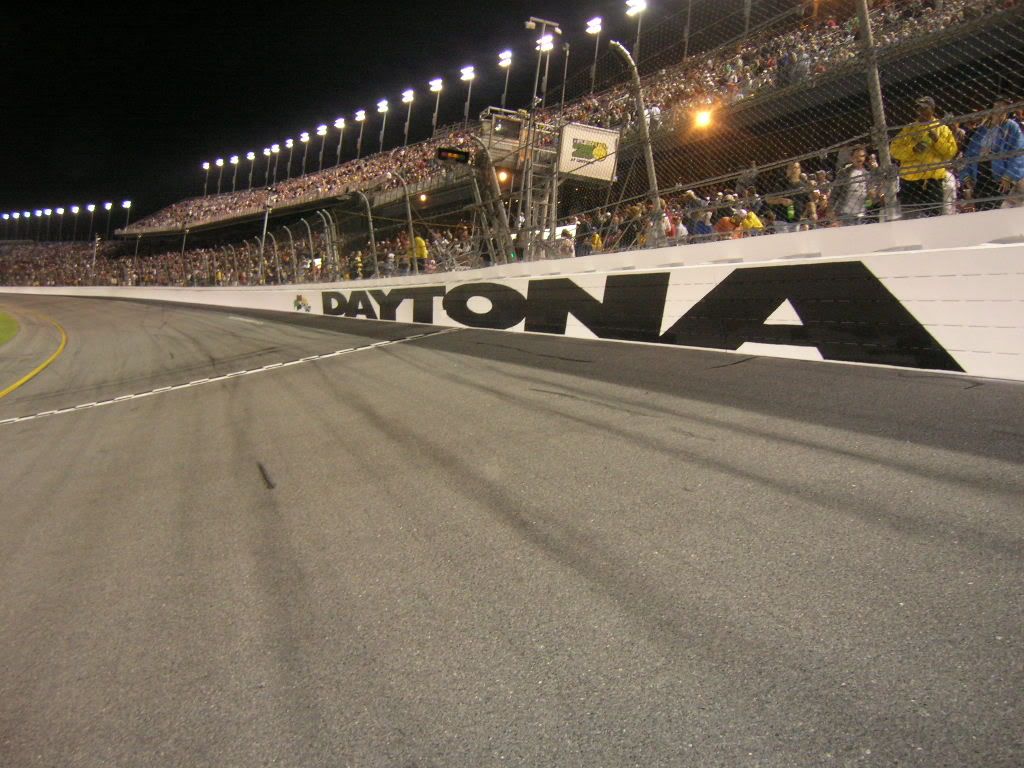It was the Truck race at Daytona in 2005. It was the sixth race at Daytona, but the first I witnessed from the grandstand side of the track. And to top it off, it was from the comfort of press box, high above the track with a crystal-clear view of every inch of the track.
I remember walking across the track. I crossed when the teams started pushing their cars to the grid from the famous Gate 7 halfway between turn four and the tri-oval. Walking with the teams was neat because I could hear the reaction some of them were drawing from the crowd.
Once at the start-finish line, I did what any red-blooded fan would do: I took a picture.

Then I headed for the crossover gate and was met by a huge throng of people. I swiftly went up the grandstands and made my way to the elevator. Within moments I was somewhere I never thought I would be, the press box at Daytona.
As a kid, I had watched the 500 every year since 1981 (and had even gone back and watched the 1979 and 1980 races on VHS too). I remember Bumper-gate in 1982, the 200 mph barrier broken in 1983 and again (officially) in 1984. The aero-coupe invasion started in 1985 with the Ford Thunderbird and has eventually changed the sport as the importance of aerodynamics became more and more pronounced.
I remember when ESPN brought us the first broadcasts of the ARCA and Nationwide races in the early 1990s. The track itself blossomed too as the Winston Tower sprung up nearly 15 stories behind the start-finish line.
And now, here I was, sitting atop that very structure.
The countdown to green was electrifying. The time, which usually seems to move very slowly, flew by at an astonishing rate. Before I knew it, the command to fire engines was given and trucks were on track.
As soon as the green waved, I instantly knew why Daytona is packed to the gills with fans for SpeedWeeks. The sight of 36 trucks slinging around the highbanks was truly breathtaking. Sure, I had a job to do, but I found it hard to take my eyes off the track to type.
The race itself was thrilling. Both Rick Crawford and Chad Chaffin went upside down and drove back to the pits in separate incidents. There was a multi-truck accident at the waving of the white flag among the lead pack and a last-second pass for the win as the yellow was waving. Jimmy Spencer went to victory lane but Bobby Hamilton eventually was awarded the win after NASCAR reviewed the SPEED tapes.
I tried to hustle down from the press box to make the winner's press conference in the media center but couldn't get there in time. I was pleasantly surprised to be invited back to Hamilton's motorhome for a private interview and chat long after his official obligations had ended. It was the perfect ending to an improbably perfect night. And for a journalist who is still a major fan of the sport, it was a memory that will last a lifetime.
PR needs to take a more prominent role
With the economy in the tank (it's effects are especially strong in the Truck and Nationwide series) teams must do everything they can to get as much positive exposure possible for their sponsors. Disappointingly many teams have cut their PR budgets at a time when they need to be shoring them up.
The team PR rep is often overlooked, and as Michael Knight points out in his SpinDoctor500 blog, often rightfully so. There is often little done to attract additional interest to unique stories that a series like the Camping World Trucks have to offer.
Teams need to hire competent, professional PR managers to pitch stories and get that exposure. Sure, we can all work with radio personalities on site and if our teams finish high enough we might get a mention in the local newspaper. But there are other opportunities that are routinely left on the table because as a whole we don't pursue them.
I hope team owners in the Truck and Nationwide Series realize the need to hire active, engaging professionals before it's too late. The PR rep needs to do much more than carry the drivers towel and bottle of water after the race.

No comments:
Post a Comment